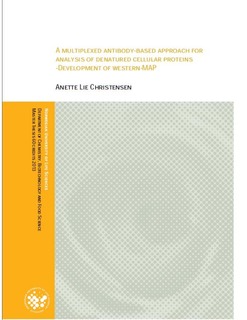| dc.description.abstract | This thesis describes a new method for multiplexed analysis of cellular proteins. The cellular proteins were biotinylated and fractionated by gel-electrophoresis using a device (Gelfree 8100), which yields liquid fractions containing proteins of different sizes. Color-coded microspheres with antibodies to cellular proteins were added to the fractions. After incubation with the microspheres, captured proteins were labelled with fluorescent streptavidin and detected by flow cytometry. The results obtained with the assay resemble those obtained with standard western blotting. However, while western blotting is used to detect one or a few proteins at a time, the array-based assay developed here can be used to measure thousands of proteins simultaneously. This approach is hereafter referred to as western-MAP (Microsphere-based Affinity Proteomics).
Variables that were found to affect performance of western-MAP included sample loading, choice of protein label, type of gels, addition of detergents and removal of free SDS from the fractions. The assay performance was optimal when the gels were loaded with 230μg of protein. Combined labelling with amine- and thiol-reactive biotin was superior to either reagent used alone. Protein detection was enhanced when SDS in the protein fractions was removed by potassium chloride (KCl) precipitation, and further enhanced by the addition the non-ionic detergent Tween 20. The most useful gels contained 8% and 10% acrylamide.
The microsphere-based arrays that were used in this study contained thousands of antibodies. Among these, 537 were found to capture a protein with a size compatible with that of the intended target. For 89 antibodies we had access to western blotting data obtained with the same cell lysates. A total of 76.4% of these antibodies showed comparable results between standard western blotting and the method developed in this thesis. Thus, the work resulted in successful multiplexing of western blot, which is one of the most widely used assays in protein research. | no_NO |
